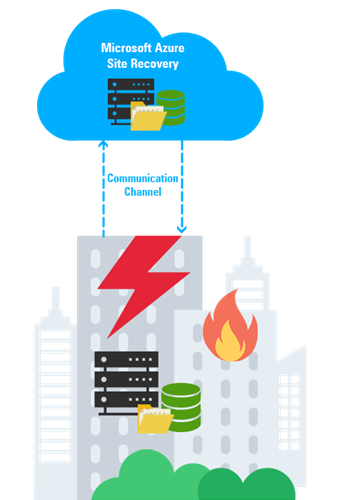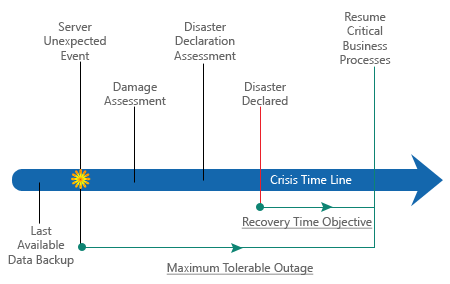Disaster Recovery Business Continuity
Business Continuity and Disaster Recovery (BCDR) denotes an organization’s ability to recover from a disaster or unexpected event and resume operations. Organizations often have a plan in place that outlines how recovery will be accomplished. The key to successful disaster recovery is to have a plan (emergency plan, disaster recovery plan, and continuity plan) well before disaster ever strikes.
Managers spend significant time and effort ensuring their data and applications are available when needed. The general approach to business continuity in the cloud is no different than any other environment. The same principles and goals apply, but the implementation and process will be different.
Availability problems can be categorized into three comprehensive set
- Failure of individual servers, devices, or network connectivity.
- Corruption, unwanted modification, or deletion of data.
- Widespread loss of facilities.

Business Continuity planning and disaster recovery planning are vital activities. Business Continuity Planning & Disaster Recovery World is designed to consider all these issues and to catalog some of the most highly acclaimed products and services. Here is software to assist with BIA and risk analysis, as well as links to tools or services to help you create, maintain and audit the plan itself.
Whether you are entirely new to business continuity and disaster recovery planning, or whether you already have a proven and established plan, the directory should hopefully prove to be of real value.
Sound disaster recovery and business continuity plans are essential to protect the wellbeing of an organization. Many organizations today do not have suitable disaster recovery protection for their applications. In most cases, disaster recovery is too expensive, complex, and undependable for any but the most mission-critical applications. Still, many companies step aside from the issue or hold plans which are clearly out of date & insufficient. Part of the reason for this is the complexity of the task which is not helped by few vendors selling planning products that are themselves extremely difficult to answer.
Disaster Recovery is a form of insurance to protect your IT assets when a disaster strikes. And just like good insurance, the best disaster recovery should provide great protection with less bother. We provide the most reliable, cost-effective, and simple disaster protection for all virtualized applications.
Organizations can effectively meet core requirements for disaster recovery:
- Rapid recovery with automation.
- Reliable recovery, non-disruptive testing automation, and simplified testing of recovery plans.
- Affordable recovery without requiring a duplicate, idle data center.

Strategies
- Site designation.
- Data back up.
- Drills.
- Back up of Key personnel.
Site Designation:
A hot site or cold site is a location that an organization can move to after a disaster if the current facility is unusable. The difference between the two is that a hot site is fully equipped to resume operations while a cold site does not have that capability. There is also a warm site that can resume few, but not all operations. The decision a company makes when determining what type of site to establish often pivots on the results of a cost-benefit analysis as well as the needs of the organization. Companies perform occasional tests and conduct trials to verify the viability and effectiveness of the plan and to determine if any shortages exist and how they can be dealt with. An audit of a company's Disaster Recovery Plan primarily looks into the probability that operations of the organization can be sustained at the level that is assumed in the plan, as well as the ability of the entity to establish operations at the site. An analysis of the disaster recovery plan generally involves examining and testing the procedures included, conducting outside research relating to Disaster recovery, determining reasonable standards relating to implementation, and touring, examining, and researching the outside facility. The security of the storage site is also confirmed.
Data Backup:
Data backups are central to any disaster recovery plan. An audit of backup processes determines if they are effective and if they are being implemented by the involved personnel. There are a couple of techniques that are used to accomplish which include direct observation of the processes in question, analyzing and researching the backup equipment used, conducting computer-assisted audit techniques and tests, examining paper and paperless records.
The continual backing up of data and systems can help minimize the impact of threats. The disaster recovery plan also includes information on how best to recover any data that has not been copied. Controls and protections are put in place to confirm that data is not damaged, reformed, or destroyed during this process. Information technology experts and procedures need to be identified that can accomplish this attempt. Vendor manuals assist in determining the best to proceed.
Drills:
Practice drills are conducted periodically to determine how effective the plan is and to determine what changes may be necessary.
Backup of key personnel:
A disaster recovery plan includes written policies and specific communication with employees to ensure that both regular and replacement personnel are selected, documented, and informed should a disaster occur. Confirmation must so that the replacement personnel can do the obligations allocated to them in an event of a backup. Periodic training and cross-training are often used to accomplish this.
There is another consideration as well.
Like Insurance issues, communication issues, Emergency Procedures & Environmental Changes.

